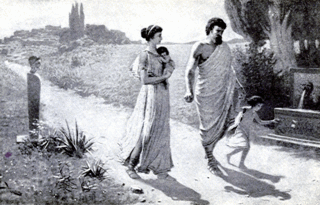Agesilaus II was king of Sparta from c. 400 to c. 360 BC. Generally considered the most important king in the history of Sparta, Agesilaus was the main actor during the period of Spartan hegemony that followed the Peloponnesian War. Although brave in combat, Agesilaus lacked the diplomatic skills to preserve Sparta's position, especially against the rising power of Thebes, which reduced Sparta to a secondary power after its victory at Leuctra in 371 BC.
Cleomenes I was Agiad King of Sparta from c. 524 to c. 490 BC. One of the most important Spartan kings, Cleomenes was instrumental in organising the Greek resistance against the Persian Empire of Darius, as well as shaping the geopolitical balance of Classical Greece.

Cleomenes III was one of the two kings of Sparta from 235 to 222 BC. He was a member of the Agiad dynasty and succeeded his father, Leonidas II. He is known for his attempts to reform the Spartan state.
Pleistoanax, also spelled Plistoanax, was Agiad king of Sparta from 458 to 409 BC. He was the leader of the peace party in Sparta at a time of violent confrontations against Athens for the hegemony over Greece.
Agesipolis I was the twenty-first of the kings of the Agiad dynasty in ancient Sparta.
Agis I was a king of Sparta and eponym of the Agiad dynasty. He was possibly the first historical king of Sparta, reigning at the end of the tenth century BC, during the emergence of the Dorians in Laconia. He is said by most ancient authors to have conquered the region and enslaved the helots.

Agis IV, the elder son of Eudamidas II, was the 25th king of the Eurypontid dynasty of Sparta. Posterity has reckoned him an idealistic but impractical monarch.
Pleistarchus was the Agiad King of Sparta from 480 to 458 BC.
Cleomenes II was king of Sparta from 370 to 309 BC. He was the second son of Cleombrotus I, and grandfather of Areus I, who succeeded him. Although he reigned for more than 60 years, his life is completely unknown, apart from a victory at the Pythian Games in 336 BC. Several theories have been suggested by modern historians to explain such inactivity, but none has gained consensus.

Leonidas II was the 28th Agiad King of Sparta from 254 to 242 BC and from 241 to 235 BC.
Anaxandridas II was an Agiad king of Sparta from c. 560 BC to 524 BC, father of Leonidas I and grandfather of Pleistarchus. Under the leadership of the ephor Chilon, in office during the middle of the 6th century, Sparta ended its streak of violent conquests, such as in Messenia, and adopted a pro-Achaea policy based on diplomacy. Anaxandridas was succeeded by Cleomenes I.
Archidamus I, also spelled ArchidamosI, was a king of Sparta, 12th of the Eurypontids. He reigned from c. 660 to c. 645.
Archidamus IV was Eurypontid king of Sparta from c. 300 BC to c. 275 BC. An obscure king, Archidamus is only known for his defeat against the Macedonian king Demetrius Poliorketes at Mantinea in 294, where he might have also died since nothing is heard of him afterwards. This defeat marks the beginning of a long eclipse for the Eurypontid kings, who are not mentioned again until the emergence of Agis IV 50 years later.
Eudamidas I was Spartan king between 331 and c. 300 BC. He succeeded his brother Agis III, who died at the battle of Megalopolis against Macedonia. Eudamidas' reign was therefore peaceful as Sparta recovered from this disaster. He even refused to join the other Greek states in the Lamian War in 323, and was later noted for his interest in philosophy—peculiar for a Spartan king.
Charilaus, also spelled Charilaos, Charillos, or Charillus, was a king of Sparta in the middle of the 8th century BC. He was probably the first historical king of the Eurypontid dynasty.

Chilonis was a Spartan princess and queen: daughter, wife, sister and grandmother of four different Spartan kings: Leonidas II, Cleombrotus II, Cleomenes III and Agesipolis III respectively.

Pausanias was the Agiad King of Sparta; the son of Pleistoanax. He ruled Sparta from 445 BC to 427 BC and again from 409 BC to 395 BC. He was the leader of the faction in Sparta that opposed the imperialist policy conducted by Lysander.
Lycurgus was a king of Sparta, who reigned from 219 BC until his death shortly before 211 BC. Of obscure background and possibly of non-royal descent, Lycurgus led Sparta in the Social War against Macedon with varying success, and underwent multiple exiles during his checkered reign. He also effectively abolished the traditional Spartan diarchy by dethroning his fellow king Agesipolis III and ruling Sparta as its sole monarch.
The navarch was the magistrate who commanded the fleet in Ancient Sparta.




